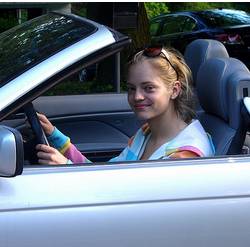We have all encountered bad drivers, whether they’re screeching round corners, tailgating or simply “road hogs”. Unfortunately, it doesn’t stop there.
Insurance Scams
Insurance scams are nothing new, just the tactics change- as insurance companies catch on and the scammers try to stay one step ahead. The latest reported is the ‘flash for cash’ scam, usually run by organized criminals where it’s your word against theirs. In this scam, criminals flash their lights or indicate that they are yielding their right of way and then crash into someone on purpose to collect the insurance. This can happen at intersections, while merging, in parking lots, etc. Be cautious of someone inexplicably yielding their right of way, it just takes a few extra seconds to wait and let them go ahead.

A related scam is where you have a minor accident and the other driver tries to claim that damage from a previous accident just occurred. Look for rust in the scratches to prove that they are old and didn’t just happen. Take pictures of the damage and be sure to capture the visible rust.
In “the phantom victim scam” people who weren’t in the car file a personal injury claim with your insurance company. This may be part of a staged accident or simply an opportunistic ploy that comes later, where the scammer tries to file claims for additional passengers, claiming pain or injury, even if they weren’t in the car. (This is especially common with online claim filings.) The best way to prevent this is with a police accident report but it also helps to take pictures of the accident scene including all participants.
When it is someone else behind the wheel, you have little control over the situation but the one thing you can do is to protect yourself by driving defensively. AXA recommends making sure you have the right insurance policy with a reliable company as a good place to start. Plus to be forewarned is to be forearmed so beware of these situations. The cost of insurance scams pushes all drivers’ premiums up, not just those affected.
Other Tips:
Young Drivers Need to be Extra Cautious
Studies from the U.K. Department of Transport and U.S. reporting agencies show that young males are involved in more crashes than females. In an interesting twist, last year the U.K. had legislation changes, closing the gap so that premiums aren’t gender based. If you live in the U.S. however, boys under the age of 25 still pay higher rates than girls. So boys need to exercise additional caution. Many insurance companies offer discounts for good students and for taking driver training courses which may help reduce the cost. But on the flip side having an accident or getting a ticket can increase your insurance rates. Although driving skills should improve with experience, bad driving habits can become ingrained, making them harder to shake as time passes, so you should strive to develop good habits from the start.
Don’t Run Your Car on Empty
We have all been guilty of occasionally letting the gas gauge slip into the red. But regularly running your car on an empty tank could damage your vehicle as the sediment that collects in the bottom of the tank gets sucked up into the engine. Also, once your car is out of gas it makes you vulnerable to all kinds of dangers. The supposed good Samaritan offering to take you to the station could have other intentions, so keep your tank topped up.
Keep Your Vehicle “Tip-Top”
Just like a car with no gas, a broken vehicle leaves you stranded and vulnerable. It is good to have an awareness of basic maintenance so that you can handle an emergency, but prevention is even better, keep your car running efficiently, check the fluids regularly and beware of any warning lights that appear on your dash. A low oil light should not be ignored! It only takes a minute or two without oil for your engine to seize. Typically, if your oil level is low, the oil light will flash on when turning a corner but then it will go off again. An oil light that stays on means “stop the car now!” your engine may seize at any moment. The oil light will come on when you first start the car, but should go off after a few seconds. Drive slowly when you first turn on the car, do not “race” a cold engine to warm it up. It is essential to allow an engine to warm-up gradually to avoid strain. It takes a few seconds for oil to circulate around the engine when it is first started so you want to give it a chance to do its job.
See Also:
- Financial Implications of a DUI
- Select your Bicycle Insurance Wisely
- Tips for Buying Car Insurance
- Life Insurance and Annuities: The Secret is the Bottom Line
- How Much Car Insurance Do I Need?
Image courtesy of Anankkml/ FreeDigitalPhotos.net”.







